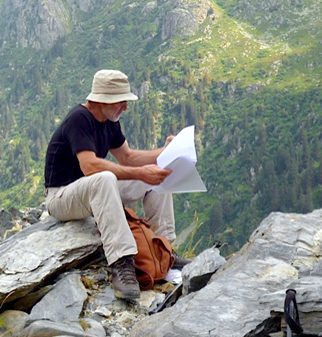
Office hours: Mon - Fri 09:00 - 17:30; Sat 09:30 - 13:00
Office hours: Mon - Fri 09:00 - 17:30; Sat 09:30 - 13:00
Office hours: East Coast USA: Mon - Fri 09:00 - 17:30 (04:00 - 12:30 local time); Sat 09:30 - 13:00 (04:30 - 08:00)
West Coast USA: Mon - Fri 09:00 -17:30 (01:00 - 09:30 local time); Sat 09:30 - 13:00 (01:30 - 05:00)
Office hours: Ottawa: Mon - Fri 09:00 - 17:30 (04:00 - 12:30 local time); Sat 09:30 - 13:00 (04:30 - 08:00)
Vancouver: Mon - Fri 09:00 - 17:30 (01:00 - 09:30 local time); Sat 09:30 - 13:00 (01:30 - 05:00)
Office hours: Canberra: Mon - Fri 09:00 - 17:30 (20:00 - 04:30 local time); Sat 09:30 - 13:00 (20:30 - 24:00)
Office hours: Mon - Fri 09:00 - 17:30 (22:00 - 06:30 local time); Sat 09:30 - 13:00 (22:30 - 02:00)
Office hours: Mon - Fri 09:00 - 17:30 (check internet for local time equivalent); Sat 09:30 - 13:00
Reasons to hike in Devon
On Foot’s Devon walking holiday in England’s West Country has been a favourite for many years, but we’ve now made it even better. Harriet has been busy re-routing and improving the two days that pass through the wilds of Dartmoor – she even walked this section in icy January weather!
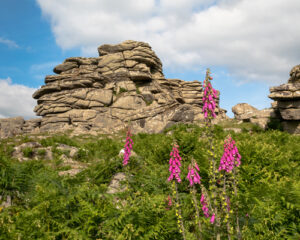 The skyline of Dartmoor is punctuated by tors – rugged outcrops of grey granite that are places of myth and legend. Our route now passes some of the most spectacular high points, including Hound Tor, which gets its name from its outline looking like massive dogs (you will need quite a lot of imagination for this…).
The skyline of Dartmoor is punctuated by tors – rugged outcrops of grey granite that are places of myth and legend. Our route now passes some of the most spectacular high points, including Hound Tor, which gets its name from its outline looking like massive dogs (you will need quite a lot of imagination for this…).
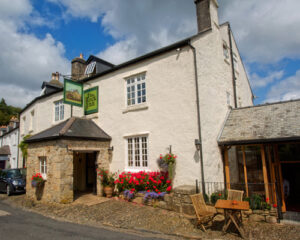
Local legend tells that a pack of hunting dogs was turned to stone after disturbing a witches’ ceremony, and also that the tor was inspiration for the Sherlock Holmes mystery, The Hound of the Baskervilles. Nearby are the ruins of a medieval village known as Hundatora.
Spend your night on Dartmoor at The Rock Inn, a historic village pub with log fires and cosy corners. The food, however, is thoroughly 21st century, and excellent!
At Haytor Rocks the next day you’re likely to see the Dartmoor ponies that roam wild, and also the abandoned quarry and the tramline which once carried stone away for the construction of buildings such as the British Museum. Once full of noise and dust, the quarry is now peaceful and the pond teems with wildlife.
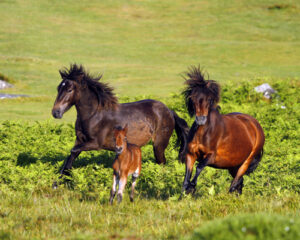
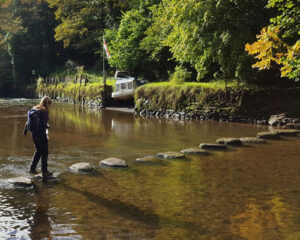
After Rippon Tor comes some quiet moorland hiking with panoramic views, then a descent to Buckland in the Moor – look out for the church and its unusual clock face. A lovely walk through woodland brings you to the River Dart and some excellent picnic spots, then on to the delightful tea room at Holne and your next inn at Scorriton.
And if that’s not enough – your holiday starts in the cathedral city of Exeter and finishes by winding down the Dart estuary to charming Dartmouth on the coast, with lots more scenic delights along the way.
Like most of our holidays in the UK, the weather is usually great for walking in July and August, so long as you book well in advance.
Find more about our Devon walking holiday here.
Thomas Hardy, one of the greatest English novelists and poets, knew and loved the rural landscapes of Dorset, spending much of his life in the county where he was born in 1840. The meadows where Tess D’Urberville milked cows, the streets walked by the Mayor of Casterbridge, the thatched cottages of Mellstock – all these were woven into his semi-fictional land where tragic characters struggled against their passions and social circumstances.
The original ‘Wessex’ was an Anglo-Saxon kingdom, and the term had long since fallen out of use until Hardy began to mention it in his novels. It has become a byword for the backdrop to Hardy’s works, and is now commonly used as an unofficial name for this region of southwest England.
There are some heights in Wessex, shaped as if by a kindly hand
For thinking, dreaming, dying on, and at crises when I stand,
Say, on Ingpen Beacon eastward, or on Wylls-Neck westwardly,
I seem where I was before my birth, and after death may be.
From “Wessex Heights” by Thomas Hardy, 1896
In his construction of Wessex, Hardy used a mixture of real and fictional names for landscape features, towns and villages, some of which you will encounter while walking On Foot Holidays’ route through Dorset, from Salisbury to Lyme Regis. At Evershot (Hardy’s ‘Evershead’), Tess D’Urberville paused for breakfast at a cottage next to the Sow and Acorn inn – in reality The Acorn Inn where Hardy was a regular customer, and where you will stay. The starting point of your walk is Salisbury, which goes by the name of ‘Melchester’ in Jude the Obscure, Bridport appears as ‘Port Bredy’ in Fellow Townsmen, and Shaftesbury is Hardy’s ‘Shaston’ in several novels.
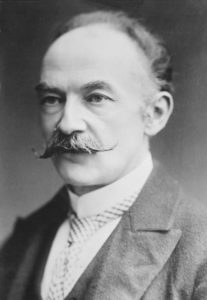
While in Salisbury, you might like to visit a new exhibition at Salisbury Museum –
Hardy’s Wessex:
The Landscapes that Inspired a Writer
Saturday 28th May to Sunday 30th October 2022
Running simultaneously across four museums (Salisbury, Dorchester, Poole and Wiltshire), each exhibit will explore a different aspect of Hardy’s relationship with Wessex, using literary sources, fashion, textiles and social history collections.
This week sees the 90th anniversary of a landmark event in the campaign for public access to walk on private land in Britain – the Kinder Scout Mass Trespass of 1932. On 24th April three groups of walkers, mostly young men from Manchester and Sheffield and numbering probably around 400, converged on the moorland plateau of Kinder Scout in England’s Peak District. Their aim was to bring attention to the fact that huge upland areas were only accessible to a privileged few for game shooting, while many thousands longed to get out of the smoky cities for a walk in open countryside.
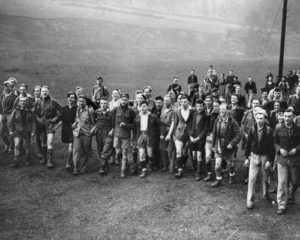 Scuffles with gamekeepers and the police who were attempting to prevent the ramblers accessing the moor resulted in five men being given short jail sentences, but the day’s events gained national publicity and sympathy for the growing campaign. It wasn’t long before volunteers and conservation bodies came together to lobby for National Parks that would both enable access and protect the countryside, and eventually the Peak District became the first National Park in the UK in 1951. The influx of visitors also led to the nearby village of Edale becoming home to the first officially organised mountain rescue team in the country.
Scuffles with gamekeepers and the police who were attempting to prevent the ramblers accessing the moor resulted in five men being given short jail sentences, but the day’s events gained national publicity and sympathy for the growing campaign. It wasn’t long before volunteers and conservation bodies came together to lobby for National Parks that would both enable access and protect the countryside, and eventually the Peak District became the first National Park in the UK in 1951. The influx of visitors also led to the nearby village of Edale becoming home to the first officially organised mountain rescue team in the country.
The anniversary of the trespass on 24th April 1965 was an auspicious day for the opening of the Pennine Way – the first National Trail in the country – which begins its 435 km (286 mile) route north from Edale, finishing at the Scottish border. And at long last, new legislation in 2000 allowed open access to registered areas of upland and uncultivated land in England and Wales. Scotland soon followed with legal formalisation of its long tradition of unhindered access to open countryside.
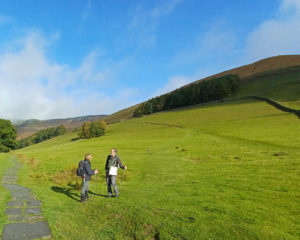 Kinder Scout forms the triumphant finale to On Foot’s self-guided walking route through the Peak District. From the pretty village of Edale, start the day by walking the first stretch of the Pennine Way, climbing Jacob’s Ladder to the edge of the moor, and then trace the edge of the plateau past fantastical rock formations and waterfalls, with wide views across the Edale valley. From the craggy promontory of Ringing Roger, drop back down to Edale for your final night, and maybe pop into the Hikers Bar of the Old Nags Head pub to raise a celebratory pint to those whose efforts many years earlier made your walk possible.
Kinder Scout forms the triumphant finale to On Foot’s self-guided walking route through the Peak District. From the pretty village of Edale, start the day by walking the first stretch of the Pennine Way, climbing Jacob’s Ladder to the edge of the moor, and then trace the edge of the plateau past fantastical rock formations and waterfalls, with wide views across the Edale valley. From the craggy promontory of Ringing Roger, drop back down to Edale for your final night, and maybe pop into the Hikers Bar of the Old Nags Head pub to raise a celebratory pint to those whose efforts many years earlier made your walk possible.

